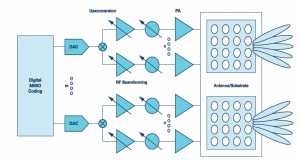Cellular communications have come a long way since the introduction of analog cellular networks in the early ’80s. Today, as the market migrates from 4G to 5G network solutions, the cellular communications industry is laying the groundwork for a giant leap forward in data transfer speed, lower latency, capacity, user density, and reliability. For example, along with a 100× improvement in data rates and network capacity (10×), 5G also drastically cuts latency to under 1 ms, while enabling near ubiquitous connectivity for the billions of connected devices that are part of the growing Internet of Things (IoT). A typical 5G beamforming transmitter comprising digital MIMO, data converters, signal processing components, amplifiers, and antennas is shown in Figure 1.
Powering FPGAs
In order to fully realize the benefits of 5G, designers require higher frequency radios to tap into the new spectrum needed to meet the future data capacity demand by incorporating more integrated microwave/millimeter wave transceivers, field programmable gate arrays (FPGAs), faster data converters, and high power, low noise power amplifiers (PAs) for smaller cells. Additionally, these 5G cells will also include more integrated antennas to apply the massive multiple input, multiple output (MIMO) techniques for reliable connections. As a result, a variety of state-of-the-art power supplies are required to power 5G base station components.

Modern FPGAs and processors are built using advanced nanometer processes because they often perform calculations at fast speeds using low voltages (<0.9 V) at high current from compact packages. Additionally, new generation FPGAs need lower core voltages to vastly improve computational speeds while requiring higher voltage for I/O interfaces, and they need an additional rail for DDR memory. So, in essence, a single FPGA requires multiple voltages with tight tolerances and different current ratings for optimal operation. What’s more, in order to avoid damage, these voltage rails must be sequenced in the correct order. Such stringent requirements can be met by power supplies built using the latest semiconductor technologies combined with leading-edge circuit topologies and advanced packaging techniques. However, should a designer not properly utilize the right power management solution, the risks range from inefficiencies to thermal complications and other undesired performance-related problem.
Quietly Powering High Speed Data Converters
Likewise, faster running, precision data converters, like analog-to-digital converters (ADCs) and digital-to-analog converters (DACs), also require multiple power rails, such as 1.3 V, 2.5 V, and 3.3 V, with very low noise and dc ripple. Normally, these high speed ADCs and DACs are placed on crowded printed circuit boards (PCBs) with limited space. Consequently, power supply sensitivity of the ADC and DAC must be a top consideration when designing the power supply system for these high speed data converters.
By combining the benefits of advanced semiconductor and packaging technologies, ADI’s μModule Silent Switcher regulators can easily solve this problem, meeting the efficiency, density, and noise performance needs of high speed data converters. A good example is Silent Switcher LTM8065, which can deliver a solution that is quiet, more compact, and more efficient for powering these devices. Unlike a traditional discrete solution, LTM8065 can significantly cut the component count and power supply board real estate without compromising the dynamic performance of the data converter. A single RoHS compliant BGA package integrates a switching controller, power switches, an inductor, and all the supporting components. In some cases, to maximize power supply rejection ratio (PSRR) performance, linear regulators are used in the power supply path, following a switching regulator. ADP7118 is one such low dropout (LDO), low noise linear regulator that can handle a wide input voltage range with high output accuracy, low noise plus high PSRR, and an excellent line and load transient response. However, there are many more in this product line and they can be correctly selected using ADI’s software tools like LTpowerCAD and LTspice.
Managing Power for PAs and Transceivers
These next-generation radios that incorporate integrated transceivers and low noise, high power microwave/millimeter wave PAs with wider bandwidths come with digital control and management systems, which requires the use of multiple specialized power-supply technologies. For example, gallium nitride (GaN)-based low noise, high power PAs will require voltages as high as 28 V to 50 V, while FPGA based control and high speed ADCs and DACs will need multiple lower voltages with proper sequencing, monitoring, and protection. State-of-the-art dc-to-dc converters can deliver the efficiency (>90%), power density, low noise performance, and control demanded by these 5G PAs. With enormous pressure to deliver next-generation (5G) products that outperform the previous generation (4G), there is little room for compromise. Consequently, a company like ADI, which specializes in all aspects of the base station RF chain and has thorough knowledge of power management tools required for powering these applications, is able to provide the right power resources for today’s 5G based PAs and transceivers. Offering the industry’s broadest portfolio of high performance Power by Linear products ranging from high efficiency, high density dc-to-dc converter modules to power management ICs (PMICs) and ultralow noise linear regulators, including power sequencing, monitoring, and protection, ADI can provide a more holistic approach to powering the 5G signal chain. ADI’s μModule regulators and Silent Switcher services are complete power system-in-package solutions that can deliver precise voltage with the highest efficiency (>95%) and power density from a miniature package with high reliability and the lowest EMI and noise. These solutions are specially designed to power high performance RF systems with the highest power conversion efficiency and density without adding noise or interference to the radio signal of interest, thus ensuring the best performance out of these RF PAs and other such RF circuits.
Likewise, to address the challenges of power supply sequencing in circuits where multiple rails are needed, ADI has built a family of sequencers ranging from sequencing of two supplies (ADM6819/ADM6820) to 17 channels (ADM1266). To ensure that a system is operating correctly, efficiently, and safely, monitoring device voltage, current, or temperature is crucial. For that, ADI offers parts like LTC2990.
Summary
ADI’s Power by Linear product portfolio comprises low noise LDO regulators, low EMI, highly integrated multirail dc-to-dc converter μModule devices, Silent Switcher technology, and other power management ICs, including supply sequencers, monitors, and protection circuits—all of which position ADI to offer the broadest line of power products in the industry. It includes everything needed to power 5G base station components, including software design and simulation tools like LTpower CAD and LTspice. These tools simplify the task of selecting the right power management solutions for these devices and, thereby, provide an optimal power solution for 5G base stations components.
Courtesy: Analog Devices

